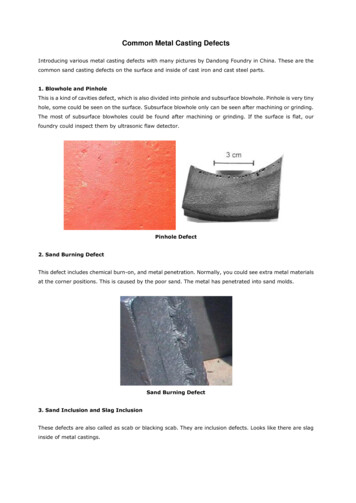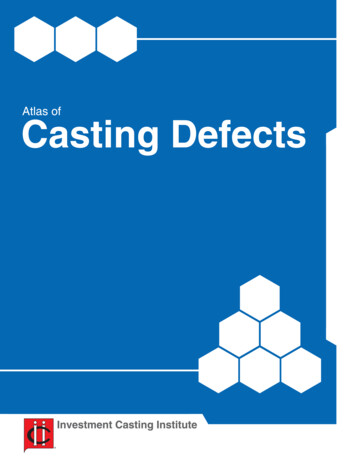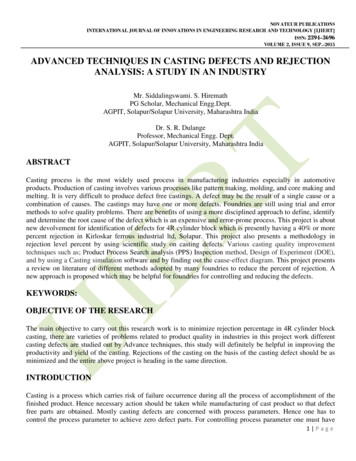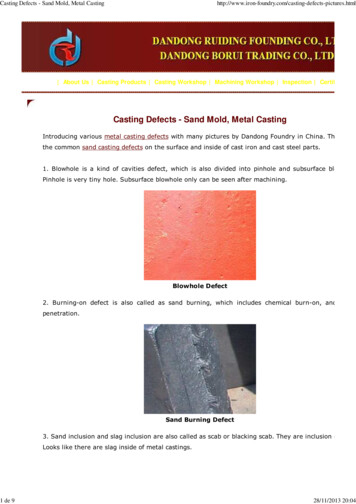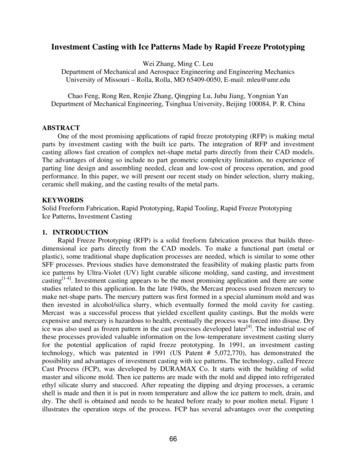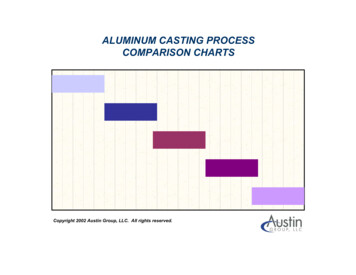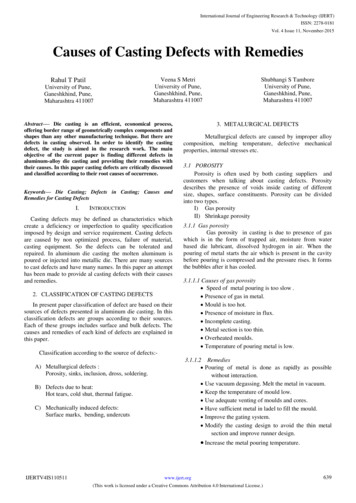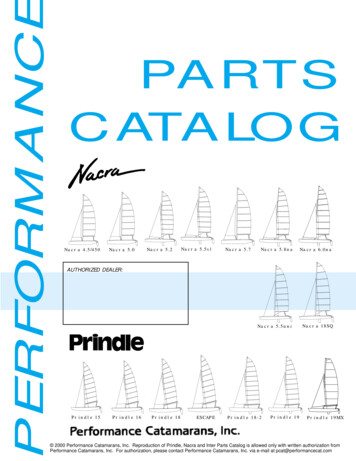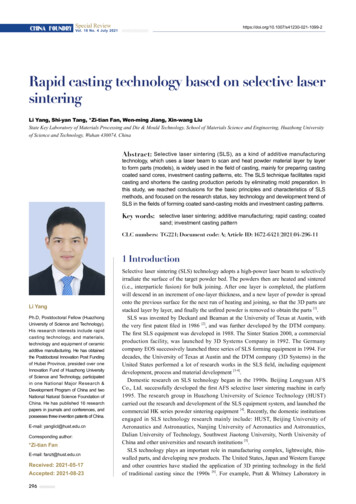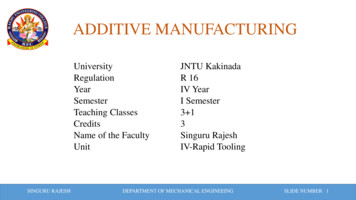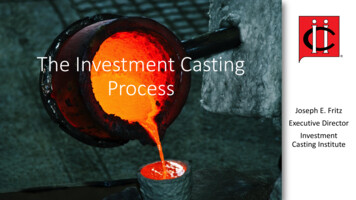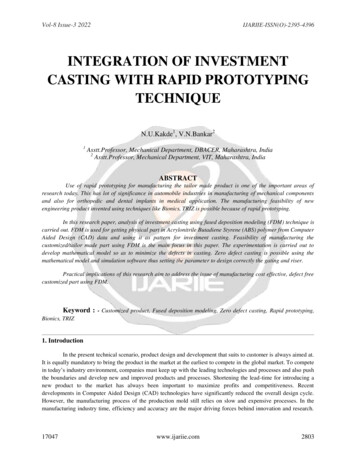
Transcription
Vol-8 Issue-3 2022IJARIIE-ISSN(O)-2395-4396INTEGRATION OF INVESTMENTCASTING WITH RAPID PROTOTYPINGTECHNIQUEN.U.Kakde1, V.N.Bankar21Asstt.Professor, Mechanical Department, DBACER, Maharashtra, India2Asstt.Professor, Mechanical Department, VIT, Maharashtra, IndiaABSTRACTUse of rapid prototyping for manufacturing the tailor made product is one of the important areas ofresearch today. This has lot of significance in automobile industries in manufacturing of mechanical componentsand also for orthopedic and dental implants in medical application. The manufacturing feasibility of newengineering product invented using techniques like Bionics, TRIZ is possible because of rapid prototyping.In this research paper, analysis of investment casting using fused deposition modeling (FDM) technique iscarried out. FDM is used for getting physical part in Acrylonitrile Butadiene Styrene (ABS) polymer from ComputerAided Design (CAD) data and using it as pattern for investment casting. Feasibility of manufacturing thecustomized/tailor made part using FDM is the main focus in this paper. The experimentation is carried out todevelop mathematical model so as to minimize the defects in casting. Zero defect casting is possible using themathematical model and simulation software thus setting the parameter to design correctly the gating and riser.Practical implications of this research aim to address the issue of manufacturing cost effective, defect freecustomized part using FDM.Keyword : - Customized product, Fused deposition modeling, Zero defect casting, Rapid prototyping,Bionics, TRIZ1. IntroductionIn the present technical scenario, product design and development that suits to customer is always aimed at.It is equally mandatory to bring the product in the market at the earliest to compete in the global market. To competein today’s industry environment, companies must keep up with the leading technologies and processes and also pushthe boundaries and develop new and improved products and processes. Shortening the lead-time for introducing anew product to the market has always been important to maximize profits and competitiveness. Recentdevelopments in Computer Aided Design (CAD) technologies have significantly reduced the overall design cycle.However, the manufacturing process of the production mold still relies on slow and expensive processes. In themanufacturing industry time, efficiency and accuracy are the major driving forces behind innovation and research.17047www.ijariie.com2803
Vol-8 Issue-3 2022IJARIIE-ISSN(O)-2395-4396The most competitive companies are those who continually reduce process times, increase efficiency and improveaccuracy. Rapid Prototyping reduces production time and increase efficiency and accuracy in developing andmanufacturing prototypes compared to traditional prototype manufacture. The research development in RapidPrototyping (RP) gives the manufacturing industry needed confidence to go on to customized/tailor made Product.Investment casting process is improved by developments in Rapid Prototyping. The process for Lost RPpattern has evolved new research avenues in the Block mold Investment Casting[10].2. Rapid PrototypingRapid Prototyping (RP) is the technique to generate three-dimensional models that need no machining ortooling. RP adds material layer by layer until the desired shape is achieved, instead of cutting away material bymachining. RP allows for more flexibility than machining because the complexity of the model does not give anylimitations to its production. RP generates 3D models quickly and accurately which helps in product design anddevelopment. Rapid prototyping is the process of generating an object directly from its digital representation inCAD/CAM system by adding material layer by layer as shown in fig 1. The main benefit of this process is to reducethe time to produce a prototype, which in turn speeds up the entire development process.Fig 1- Rapid Prototyping approach2.1 FDMFDM is the second most widely used rapid prototyping technology, after stereo lithography. A plasticfilament, approximately 1/16 inch in diameter, is unwound from a coil (A) and supplies material to an extrusionnozzle (B) as shown in fig 2. Some configurations of the machinery have used plastic pellets fed from a hopperrather than a filament. The nozzle is heated to melt the plastic and has a mechanism which allows the flow of themelted plastic to be controlled. The nozzle is mounted to a mechanical stage (C) which can be moved in horizontaland vertical directions. As the nozzle is moved over the table (D) in the required geometry, it deposits a thin bead ofextruded plastic to form each layer. The plastic hardens immediately after being squirted from the nozzle and bondsto the layer below.Fig 2- Principal of FDMThe entire system is contained within an oven chamber which is held at a temperature just below the melting pointof the plastic. Thus, only a small amount of additional thermal energy needs to be supplied by the extrusion nozzleto cause the plastic to melt. This provides much better control of the process. Support structures must be designed17047www.ijariie.com2804
Vol-8 Issue-3 2022IJARIIE-ISSN(O)-2395-4396and fabricated for any overhanging geometries and are later removed in secondary operations. Several materials areavailable for the process including a nylon-like polymer and both machinable and investment casting waxes. Theintroduction of ABS plastic material led to much greater commercial support material which is easily removable bysimply breaking it away from the object. Water-soluble support materials have also become available which can beremoved simply by washing them away.2.2 Rapid ManufacturingRapid manufacturing (RM) is the use of additive fabrication technology like RP to produce useable products orparts. As is the case with rapid prototyping, the field is also known by several other names such as additivemanufacturing, direct fabrication and direct digital manufacturing. RM is one of the three major blossomingoutgrowths of rapid prototyping. The others are three-dimensional printing - a lower-cost flavor of RP, and rapidtooling - actually a special case of rapid manufacturing. Today the distinctions among the trunk and branches of theRP tree are not very clear. Moreover, these differences can be expected to continue to blur as the technologiesmature and applications, specifications and capabilities of the branches increasingly overlap.2.3 Geometric FreedomEssentially all additive fabrication technologies provide the ability to fabricate with unbounded geometricfreedom. It is the most important advantage over subtractive methods and main reason to exist. Geometric freedomcomes with several limitations. The speed of fabrication using RP is much slower compared to standardmanufacturing methods. By some estimates, existing mass production methods are 10 to 1,000 times faster. Thefinishes and accuracy are also not on a par with conventional technology.3. Investment casting using RP3.1 Investment castingsInvestment casting is a process that has been practiced for thousands of years, with lost wax process being one of theoldest known metal forming techniques. From 5000 years ago, when bees wax formed the pattern, to today’s hightechnology waxes, refractory materials and specialist alloys, the castings are produced with the key benefits ofaccuracy, repeatability, versatility and integrity. Investment casting is one of the most economical ways to producecomplex shaped parts from metal. It is widely used for producing ferrous and nonferrous metal parts. The onlyprocess that matches this group of materials is machining, but it cannot produce the complex geometries thatinvestment casting can deliver. Each metal casting requires one wax pattern, and these patterns are injection molded.As design complexity rises, the tooling often becomes too costly and too time consuming to make prototyping andlow-volume production practical.3.2 FDM & Investment CastingThe key advantage of FDM (fused deposition modeling) is that it eliminates the need for tooling. Injection molds forwax patterns range from 3,000 to 30,000, and building the tools can take four to six weeks. The time and costsavings are true no matter how complex the part design as shown in fig 3.17047www.ijariie.com2805
Vol-8 Issue-3 2022IJARIIE-ISSN(O)-2395-4396(a)(b)Fig 3-(a) Traditional method of Investment Casting and (b) Rapid Casting (RC) methodSince FDM is an additive fabrication technology, there is no impact on the investment or delivery schedule as thepattern becomes more complex. Another advantage, which is unique to FDM, is that the soluble support technologyallows interior passages to be constructed. Additional time savings also occur in casting design, since FDM patternscan be produced without adding draft angles to the CAD data. A final consideration is the durability of the pattern.Patterns made from foundry molding wax and other additive fabrication technologies are easily damaged[10]. And,transportation and routine handling can result in broken patterns. The ABS material is also resistant to distortionfrom heat, humidity and post curing which can be an issue with other additive fabrication technologies[3].4. EXPERIMENTATIONInvestment casting process is quite different process when compared to the sand casting or other similarcasting process. ABS part of which mould cavity is to be prepared is placed on surface and around it x-ray film orany other film is placed and fix with packing wax. With the help of simulation software, runner and pouring basinare designed. Slurry is made by mixing Zirconium sand with water or biosol liquid[9]. The slurry is poured into theassembly and allowed to settle. The details about experimental setup are shown in fig 4 which are self explanatory.Fig 4(a) - X-Ray film around ABS partFig 4(b) – Gating and feeder system of wax attached to spcimen17047www.ijariie.com2806
Vol-8 Issue-3 2022IJARIIE-ISSN(O)-2395-4396Fig 4(c) – Biosint extra powderFig 4(d) – Powder clinging using vibrator machineFig 4(e) – Mold after soaking for 40Fig 4(f) – Furnace and Baked moldMathematical expression for deciding temperature range at which ABS part in mould cavity completelyevaporates is obtained. Surface response approach is used for development of a model and analysis of temperature(T), with volume of RP ABS part, Shell thickness, and set time as input parameters. Mathematical expression iscompletely based on RSM (Response Surface Methodology) theory the correlation between the response and thevariables. The mathematical model is then developed that illustrate the relationship between the process variable andresponse [6].Based on the experimental observations the following expression is obtained.Where V-Volume of ABS partSt –Shell Thickness.By using this temperature range we calculate the temperatures for various shell thickness. As in ourresearch work we take nonlinear shape so that shell thickness is not constant for single part. So we calculate the shellthicknesses at different locations and take average of all.17047www.ijariie.com2807
Vol-8 Issue-3 2022S.NPARTIJARIIE-ISSN(O)-2395-4396VOLUME OF ABS3PART Burn663.871.5538CompleteBurnFig 5- Complete burn condition for RP partFrom fig 5 we observed that by using mathematical expression of temperature we get the completely burncavities.5. Observations and AnalysisDuring experimentation readings for mold filling time and solidification time for the parts of which photographs areshown in fig 6, are noted. Using simulation software the same parameters i.e. mold filling time and solidificationtime for parts are also calculated. Data of the readings are shown in fig 6.The difference in the readings is also shown in fig 6. The difference between the actual values and valuesobtained using simulation software is mainly because of the limitation of simulation software[5]. In fig 7 dimensionsand weights of the parts in actual and as obtained in simulation software for the same part are also shown. The17047www.ijariie.com2808
Vol-8 Issue-3 2022IJARIIE-ISSN(O)-2395-4396difference as noted in the fig 7 is mainly because of the limitations of the software as the simulation software uses.stl format as file and there is no facility of providing information regarding shrinkage allowance[13]. If observedthe data given in table below, by seeing first instance, it can concluded that there are lots of mismatching betweendata given by simulation software and actual result, but it is not like that. After pouring the molten metal into mouldcavity, metal has capability to shrink during solidification. Therefore there may be some changes in dimension ofactual RP part and casting part. It gives part values and probable wt. after casting.17047www.ijariie.com2809
Vol-8 Issue-3 2022IJARIIE-ISSN(O)-2395-4396Fig 6- Results of dimension and weight between software and actual4. CONCLUSIONSIn casting product development, design information is important in process determination, tooling design,casting system, and product assurance and control. Traditionally, this information can only be revealed via the tryoutrealization of design solution in workshop. Use of simulation software, however, is an efficient approach inproviding design information to casting product design.With FDM patterns, investment casting is practical for casting and low volume production applications.Making investment casting patterns out of ABS materials saves both time and money on low volume productionapplications as well as tooling in investment casting. With only minor modification to the pattern design and theburnout process, FDM technology eliminates the costly and time-consuming tool making step needed for lost waxcasting. Industries thus can take advantage of this technique on the efficiency, capability and quality of investmentcasting.5. ACKNOWLEDGEMENTThe research work is possible because of RGSTC grant of Government of Maharashtra.17047www.ijariie.com2810
Vol-8 Issue-3 2022IJARIIE-ISSN(O)-2395-43966. REFERENCES1) Ingole, DS, & Kuthe, AM 2009 ‘Rapid Prototyping –a technology transfer approach for rapid tooling’, EmerladGroup Pub.Ltd2) Yao, WL & Leu MC 1999, Analysis of shell cracking in investment casting with laser stereolithography pattern,MCB University Press3) Rodriguez, JF & Thomas, JP 2001, Mechanical behaviour of ABS fused deposion materials, MCB UniversityPress4) Ravi, B 2006, Metal Casting, Prentice-Hall of India Private Limited, M-97, New Delhi5) Ravi, B 2008, ‘Casting Method optimization driven by simulation’, Minerals & Metals Review6) Sheikh, A 2009, ‘Process Development for Rapid Manufacturing using RP’, V.N.I.T, Nagpur7) Joshi, D & Ravi, B, Environmental Impact of Ferrous Castings, Quantified using Lifecycle Analysis Tools, IndianFoundry Journal, 52(1), 33-428) Soman, C, Rangraj N & Ravi, B 1998, A supply Chain Perspective on Initiatives in the Casting Industry, IndianFoundry Journal, 44(2), 15-22,9) Prof. Dr.-Ing. Andreas Bührig-Polaczek, “Ceramic moulding method/Investment casting-Practical”, RWTH 200810) Ford, DA 2008, Future Trends in Investment Casting – Drivers for Development, Jourrnal11) C. W. Lee Æ C. K. Chua Æ C. M. Cheah L. H. Tan Æ C. Feng 2004, Rapid investment casting: direct andindirect approachesvia fused deposition modeling, Int J Adv Manuf Technol 23: 93–10112) Joshi, D & Ravi, B 2009, Classification and Simulation based Design of 3D Junctions in Castings, AmericanFoundry Society13) Nagahanumaiah, Ravi, B & Mukherjee, NP 2003, ‘ Tool path planning for investment casting of functionalPrototypes / Production moulds’ National conference, Durgapur September 22-2317047www.ijariie.com2811
Investment casting process is improved by developments in Rapid Prototyping. The process for Lost RP pattern has evolved new research avenues in the Block mold Investment Casting[10]. 2. Rapid Prototyping Rapid Prototyping (RP) is the technique to generate three-dimensional models that need no machining or tooling.
